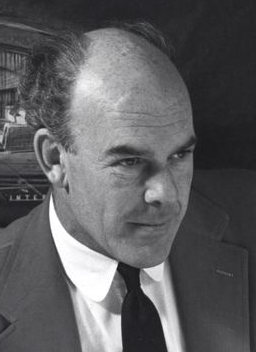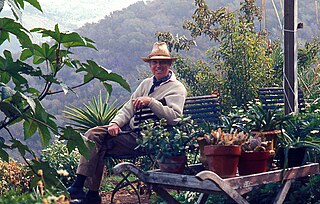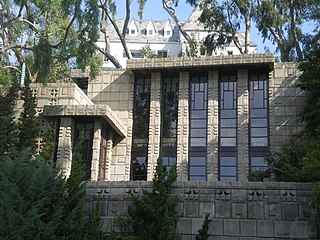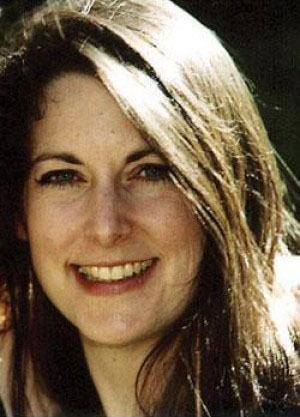Related Research Articles

Frank Lloyd Wright was an American architect, designer, writer, and educator. He designed more than 1,000 structures over a creative period of 70 years. Wright played a key role in the architectural movements of the twentieth century, influencing architects worldwide through his works and hundreds of apprentices in his Taliesin Fellowship. Wright believed in designing in harmony with humanity and the environment, a philosophy he called organic architecture. This philosophy was exemplified in Fallingwater (1935), which has been called "the best all-time work of American architecture".

The Hollywood Bowl is an amphitheatre in the Hollywood Hills neighborhood of Los Angeles, California. It was named one of the 10 best live music venues in the United States by Rolling Stone magazine in 2018.

The Frederick C. Robie House is a U.S. National Historic Landmark now on the campus of the University of Chicago in the South Side neighborhood of Hyde Park in Chicago, Illinois. Built between 1909 and 1910, the building was designed as a single family home by architect Frank Lloyd Wright. It is considered perhaps the finest example of Prairie School, the first architectural style considered uniquely American.

The Ward W. Willits House is a home designed by architect Frank Lloyd Wright. Designed in 1901, the Willits house is considered one of the first of the great Prairie School houses. Built in the Chicago suburb of Highland Park, Illinois, the house presents a symmetrical facade to the street. One of the more interesting points about the structure is Wright's ability to seamlessly combine architecture with nature. The plan is a cruciate with four wings extending out from a central fireplace. In addition to stained-glass windows and wooden screens that divide rooms, Wright also designed the furniture for the house.

Frank Lloyd Wright Jr., commonly known as Lloyd Wright, was an American architect, active primarily in Los Angeles and Southern California. He was a landscape architect for various Los Angeles projects (1922–1924), provided the shells for the Hollywood Bowl (1926–1928), and produced the Swedenborg Memorial Chapel at Rancho Palos Verdes, California (1946–1971). His name is frequently confused with that of his more famous father, Frank Lloyd Wright.

John Edward Lautner was an American architect. Following an apprenticeship in the mid-1930s with the Taliesin Fellowship led by Frank Lloyd Wright, Lautner opened his own practice in 1938, where he worked for the remainder of his career. Lautner practiced primarily in California, and the majority of his works were residential. Lautner is perhaps best remembered for his contribution to the development of the Googie style, as well as for several Atomic Age houses he designed in the late 1950s and early 1960s, which include the Leonard Malin House, Paul Sheats House, and Russ Garcia House.

Florida Southern College is a private college in Lakeland, Florida. In 2019, the student population at FSC consisted of 3,073 students along with 130 full-time faculty members. The college offers 50 undergraduate majors and pre-professional programs, graduate programs in nursing, business, and education as well as post-graduate programs in nursing, education, and physical therapy.

The Aline Barnsdall Hollyhock House in the East Hollywood neighborhood of Los Angeles, California, was designed by Frank Lloyd Wright originally as a residence for oil heiress Aline Barnsdall. The building is now the centerpiece of the city's Barnsdall Art Park. In July 2019, along with seven other buildings designed by Wright in the 20th century, it was added to the UNESCO World Heritage List. It is the first time modern American architecture has been recognized on the World Heritage List. The Hollyhock House is noted for developing an influential architectural aesthetic, which combined indoor and outdoor living spaces.

Barnsdall Art Park is a city park located in the East Hollywood district of Los Angeles, California. Parking and arts buildings access is from Hollywood Boulevard on the north side of the park. The park is a Los Angeles Historic-Cultural Monument, and a facility of the City of Los Angeles Department of Cultural Affairs.
Eric Lloyd Wright was an American architect, son of Frank Lloyd Wright Jr. and the grandson of the famed Frank Lloyd Wright.

The Oscar B. Balch House is a home located in the Chicago suburb of Oak Park, Illinois, United States. The Prairie style Balch House was designed by famous architect Frank Lloyd Wright in 1911. The home was the first house Wright designed after returning from a trip to Europe with a client's wife. The subsequent social exile cost the architect friends, clients, and his family. The house is one of the first Wright houses to employ a flat roof which gives the home a horizontal linearity. Historian Thomas O'Gorman noted that the home may provide a glimpse into the subconscious mind of Wright. The Balch house is listed as a contributing property to a U.S. federally Registered Historic District.

The Gerald B. and Beverley Tonkens House, also known as the Tonkens House, is a single story private residence designed by American architect Frank Lloyd Wright in 1954. The house was commissioned by Gerald B. Tonkens and his first wife Rosalie. It is located in Amberley Village, a village in Hamilton County, Ohio.

Herbert and Katherine Jacobs Second House, often called Jacobs II, is a historic house designed by Frank Lloyd Wright and built west of Madison, Wisconsin, United States in 1946–1948. The house was the second of two designed by Frank Lloyd Wright for journalist Herbert Jacobs and his wife Katherine. Its design is unusual among Wright's works; he called the style the "Solar Hemicycle" due to its semicircular layout and use of natural materials and orientation to conserve solar energy. The house was added to the National Register of Historic Places in 1974 and declared a National Historic Landmark in 2003.

Anthony Duquette was an American artist who specialized in designs for stage and film.

Storer House is a Frank Lloyd Wright house in the Hollywood Hills of Los Angeles built in 1923. The structure is noteworthy as one of the four Mayan Revival style textile-block houses built by Wright in the Los Angeles area from 1922 to 1924.

John Sowden House, also known as the "Jaws House" or the "Franklin House", is a residence built in 1926 in the Los Feliz section of Los Angeles, California by Lloyd Wright. The house is noted for its use of ornamented textile blocks and for its striking facade, resembling either a Mayan temple or the gaping open mouth of a great white shark.

Millard House, also known as La Miniatura, is a textile block house designed by Frank Lloyd Wright and built in 1923 in Pasadena, California. It was listed on the National Register of Historic Places in 1976.

The Goetsch–Winckler House is a building that was designed by Frank Lloyd Wright, built in 1940. It is located at 2410 Hulett Road, Okemos, Michigan. The house is an example of Wright's later Usonian architectural style, and it is considered to be one of the most elegant. The house was added to the National Register of Historic Places in 1995 and is #95001423.

The Harvey P. Sutton House, also known as the H.P. Sutton House, is a six-bedroom, 4,000-square-foot (370 m2) Frank Lloyd Wright designed Prairie School home at 602 Norris Avenue in McCook, Nebraska. Although the house is known by her husband's name, Eliza Sutton was the driving force behind the commissioning of Wright for the design in 1905–1907 and the construction of the house in 1907–1908.

Maria Louise Newman is an American composer of classical music, violinist and pianist. She is the youngest child of Alfred Newman, a major Hollywood film composer. Maria holds the Louis and Annette Kaufman Composition Chair; and the Joachim Chassman Violin Chair at the Montgomery Arts House for Music and Architecture in Malibu, California, and is a founder of the Malibu Friends of Music. Her library of original works represents a range of genres, from large-scale orchestral works, works for the ballet, chamber works, choral and vocal works, to new collaborative scores for vintage silent film. She has been presented with many awards and commissions, including musical commendations from the United States Congress (2009), the California State Senate (2009), the California State Assembly (2009), the City of Malibu (2010), and the Annenberg Foundation (2011).